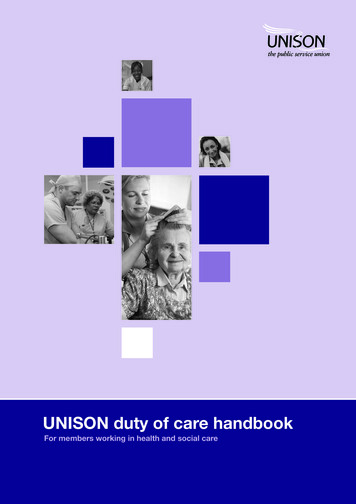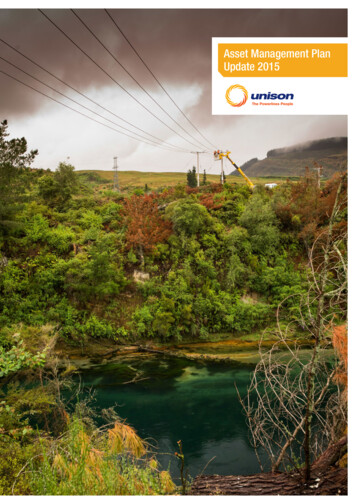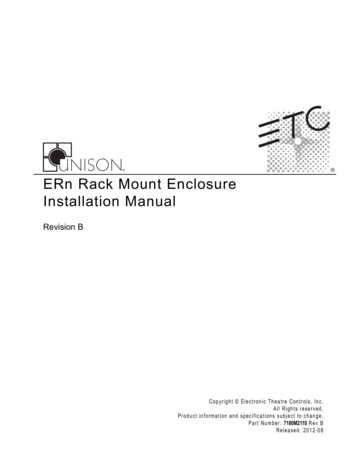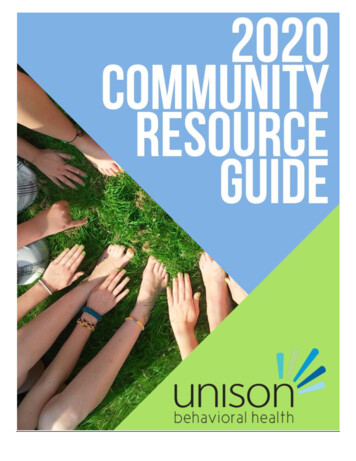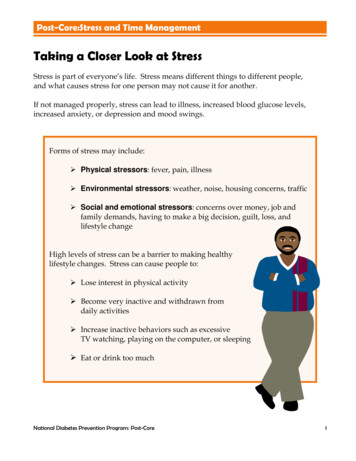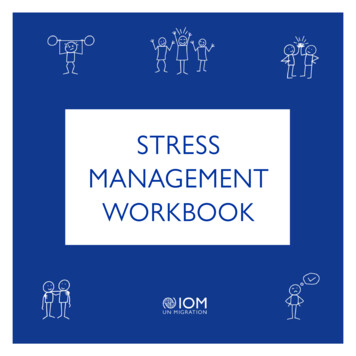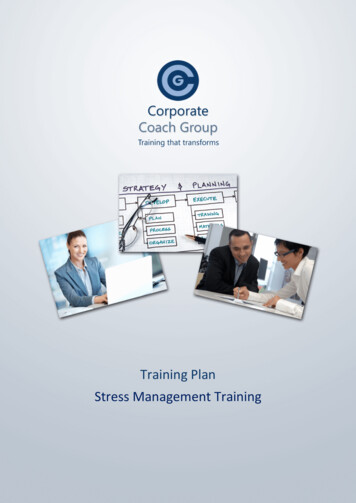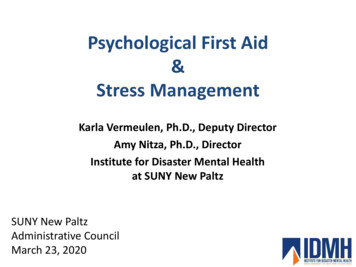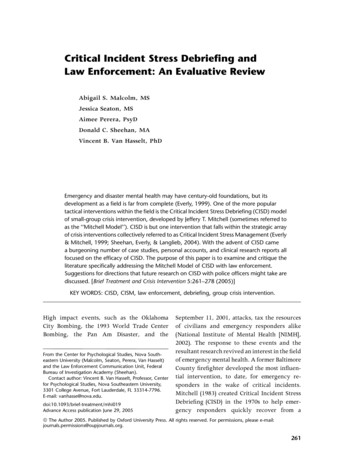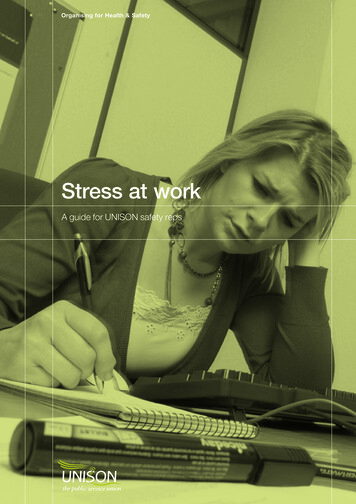
Transcription
Organising for Health & SafetyStress at workA guide for UNISON safety reps
UNISON’s guide to stress at workContentsDefinition and introduction3Work-related stress: facts and figures4Causes of stress5Causes of work-related stress, anxiety and depression5Symptoms of stress and cost to employers and society6What the law says7Stress management policies and what they should contain8Using the stress “Management Standards”8Setting up a steering group and developing a stress management programme9Risk assessment9Support for stressed workers11Campaigning and organising around stress12Case study12Safety rep checklist13Appendix: further reading142
Definition and introductionWork related stress is defined by the Health andSafety Executive (HSE) as the “adverse reactionpeople have to excessive pressures or other typesof demand placed on them” (HSE Guide: “Managingthe causes of work-related stress”, see appendix fordetails). This distinguishes between the beneficialeffects of reasonable pressure and challenge, whichcan be stimulating and motivating, and work relatedstress, which is the natural but distressing reactionto demands or work pressures that an individualperceives they cannot cope with.Although its causes may vary, stress is an issue thataffects nearly all workplaces. This guide seeks toexplain to safety reps what they need to know torepresent, negotiate, campaign and organise aroundstress. It explains:n the causes and symptoms of stressn what the law saysn what should be included in an employer’s stressmanagement policyn what the HSE’s Stress Management Standardsare and why they are importantn how to set up a stress “steering group”n how to conduct a risk assessment using theStress Management Standardsn what support should be provided for stressedworkers (including a section on combating the“resilience” agenda)n how, using a case study, to campaign andorganise around stress.3
UNISON’s guide to stress at workWork-related stress:facts and figuresStress levels: The 2014 survey of UNISON safetyreps showed stress to be their number one cause ofconcern in the workplace. 92% said that stress wasamong their top five concerns with 42% saying itwas their number one cause of concern.In addition although in the earlier part of thismillennium cases of work-related stress appear tofall, such cases have risen sharply since 2010 (seefigure 1).Figure 1: Number of self reported cases of stress, anxiety and depression480474468460Number of casesin thousands4464644354404204002007/842008/92009/10 2010/11 2011/12
Causes of stressFigure 2: 2012 HSE Labour Force Survey: Causes of work-related stressNumber of casesin agnhaCeskortwe,cenors ngta ire ullyht berOthloViCauses of work-related stress, anxiety and depressionThe increase in stress related cases in recent yearshas coincided with cuts in public services and joblosses. As well as causing anxiety and uncertaintyamong the workforce it has also led to increases inworkloads with fewer staff being asked to do more.As the Health and Safety Executive (HSE) figures(see figure 2) demonstrate, the number one causeof stress is increases in workload. However, theyalso show that lack of support and control, changesat work, role uncertainty and violence and bullying(all possible symptoms of job cuts) are significantfactors.Other causes of stress could include:n low payn unrealistic targets or deadlinesn shiftworkn poor managementn bad relations with other colleaguesn repetitive work, boredom and lack of jobsatisfactionn working alonen a poor working environment (such as excessivenoise, the presence of dangerous materials,overcrowding, poor facilities, or extremes oftemperature or humidity).5
UNISON’s guide to stress at workSymptoms of stress and costto employers and societyStress can manifest in a variety of symptomsincluding:n changes in behaviourIn addition the HSE Labour force survey shows thatover the last five years nearly 56 million working dayshave been lost to stress related illnesses. Althoughthese figures fell between 2007/8 and 2009/10 fromwell over 13 million to just under 10 million theyhave started to rise again to over 10 million for both2010/11 and 2011/12.n unusual tearfulness, irritability or aggressionn indecisivenessn increased sickness absencen poor timekeepingn reduced performanceIn addition there are the costs of presenteeism(ie. staff attending work when they are not fit todo so). The Sainsbury Centre for Mental Healthestimates presenteeism costs 1.8 times more thanabsenteeism (see appendix for details).n inability to concentraten overworking or failure to delegaten erosion of self-confidencen relationship problems, for example, becomingwithdrawn or argumentative with colleaguesn increased unwillingness to co-operate oraccept advicen excessive smoking or drinkingn drug abusen anxiety and depressionn panic attacksn other health complaints such as headaches,raised blood pressure, indigestion, muscletension and increased heart rate.6
What the law saysEmployers have the same legal requirement tomanage work-related stress as they have with anyother hazard. UNISON has been at the forefrontof taking civil cases for damages for stress atwork, and has had some success. However,winning such a stress related claim is not easy, andavoiding the harm caused by stress is preferableto compensating it. Therefore it is better to use thelaw to negotiate improved agreements and workingconditions with your employer rather than resort torisky and costly legal actions which may or may notbe successful.The 1974 Health and Safety at Work Actrequires employers to ensure the health, safety andwelfare of their employees. The Management ofHealth and Safety at Work Regulations 1999requires employers to assess the risks of ill health(including stress related conditions) arising fromwork-related activities, ensuring that the hazards areremoved or proper control measures are put in placeto reduce the risk so far as is reasonably practical.This is defined by the HSE as “balancing the level ofrisk against the measures needed to control the realrisk in terms of money, time or trouble”.For information generally on how to conduct a riskassessment you should read “Risk assessment, aguide for UNISON safety reps”. See also HSE webpages on “Controlling the risks” (see appendix fordetails of both).Other legislation that may be relevant to work relatedstress includes:n The Working Time Regulations 1998: theseplace limits on the length of the working day andweek, and make paid holidays a legal entitlement.These requirements may alleviate some of theworst causes of stress – long hours and a lack ofrest. Detailed information on these regulations isavailable on the UNISON website (see appendixfor details).n The Equality Act 2010: stress may be asymptom of an underlying condition that couldamount to a disability. Under the Equality Actemployers are required, in such an eventuality, tomake reasonable adjustments to the workplace,such as reducing an employee’s workload wherethey are under stress. For further advice onhealth and safety and disability read the UNISONguide, Disability Health and Safety (see appendixfor details). In addition the sex discriminationprovisions of this act may be used where stressis caused by for example, a male line managertreating female staff in an overbearing anddominating way. Similarly the race discriminationprovisions may be used where stress iscaused by a manager treating an employee ina discriminatory way on the grounds of theirrace. For further information on all forms ofdiscrimination and the 2010 Equality Act pleasesee appendix.n The Protection from Harassment Act 1997:this may be relevant where stress is caused byharassment.For further advice on what is required to wina legal case on work-related stress, includingdetails of landmark cases (such as the UNISONcase Walker vs. Northumberland CountyCouncil), please go to the Thompsons Website(see appendix for details).7
UNISON’s guide to stress at workStress management policiesand what they should containA stress management policy signals that youremployer is committed to meeting its’ legalobligations of reducing and minimising stress. It mustbe compliant with the relevant health and safety andequality legislation. It should be based on the HSE’sstress “Management Standards” or its equivalent(see below), and the outcome of a robust riskassessment. The policy can also assist in creating amore open climate for discussing stress, its causesand the rehabilitation of those suffering from stress.What is considered a good policy will depend on thecontext of where you are working. This includes:n the type of employer you are working forn the type of work you are employed in.In addition the greater the organising strength of yourbranch the more robust the policy is likely to be indefending the health and welfare of your members.Any stress policy should be agreed and developed inpartnership with UNISON and contain the following:work-related stress. This could include:—— reduction of workload—— change of duties—— change of working environment—— time off work—— counselling and other support services.n a date for a review of the policy.Using the stress“Management Standards”In order to help employers risk assess, identify andmanage the causes of stress the HSE has developedthe stress “Management Standards”. These coverthe six potential stressors that if not properlymanaged, are likely to lead to “poor health and wellbeing, lower productivity and increased sicknessabsence” (see HSE publication “Managing thecauses of work-related stress”, p.6, see appendix fordetails). These six stressors are:1. Demands: workloads, conflicting priorities,unrealistic deadlines, emotional demandsn an agreed working definition of stressn a recognition that stress is a health and safetyissuen statements defining both the legal and moralresponsibilities of employers, senior staff (eg thechief executive), managers and workersn a recognition of the legal rights and role of tradeunions and trade union safety reps;n a commitment from senior staff to implementingthe policy, tackling stress and its underlyingcausesn support and training for managers in managingstressn support and services for workers suffering from82. Control: how much say a worker has in the waythey do their work3. Support: the support and encouragementworkers get from their employer, manager andcolleagues4. Relationships: this includes a positive workingenvironment, and procedures for managingconflicts and dealing with unacceptablebehaviour5. Role: managers ensuring workers understandtheir roles and that that these roles do not conflict6. Change: how employers manage andcommunicate organisational change includingconsultation.
Although these standards are not mandatory theyare designed to help employers measure how wellthey are performing in managing the potential causesof work-related stress. If your employer is not usingthe “Management Standards” they will be requiredto provide alternative key performance indicators,and carry out a similar level of analysis. The TUCand UNISON have campaigned and lobbied forall employers to implement the “ManagementStandards” as a minimum benchmark to managingstress in the workplace.Setting up a steering groupand developing a stressmanagement programmeIt is important that implementing the ManagementStandards (or their equivalent) does not become atick box exercise. One of the first practical steps anorganisation can take, as both the TUC and HSErecommend, is to set up a group to oversee a stressmanagement programme, i.e. a programme of workaimed at identifying, managing and preventing thecauses of work-related stress.This joint trade union/employer steering group couldbe the existing health and safety committee, or agroup set up specifically for this purpose. Howeverif it is a separate group it is essential that it containstrade union representation and should in someway be accountable to the joint health and safetycommittee. HSE guidance describes in detail theroles and responsibilities of the different parts of anorganisation that could be a part of such a group.These include:1. Senior management (eg chief executiveofficers - CEOs) - have a duty to understandwhat work-related stress is, to champion, lead byexample and to ensure resources are provided totackle stress.2. Health and safety managers responsible forensuring that the risk of work-related stress isproperly identified and managed.3. Human resources – responsible for ensuringthat the necessary policies and procedures aredeveloped, implemented, and communicated tostaff (through their line managers).4. Line managers – responsible for, withinthe work places they manage, implementingthe policies and procedures, carrying out thenecessary risk assessments and engaging,communicating and raising awareness aboutstress.5. Occupational health services – responsiblefor working with individuals who are experiencingwork related stress and helping them remain at,or return to, work successfully. They also have arole in supporting the organisation by providingaccess to information and helping identifyparticular problems or trends that may need to beaddressed.6. Employees and their trade unionrepresentatives – employees should be awareof, and co-operate with their managers in theimplementation of their organisation’s policies andprocedures. They should also be encouragedto raise any concerns with both their managerand trade union safety rep about possibleproblems and sources of stress. Trade unionrepresentatives are urged to encourage theiremployers to tackle stress and work with themin developing policies and procedures to tacklestress, and engage and communicate with theirmembers.Risk assessmentEmployers have a duty to risk assess workrelated stress as they do any other hazard. A riskassessment is a way of identifying the hazards orthings that may cause harm, assessing the likelihood(risk) of these hazards causing harm, and thenputting in place all “reasonably practical” steps toavoid and minimise them. This is often summarisedas a five step approach. The HSE stress“Management Standards” have been designed to9
UNISON’s guide to stress at workfollow the five steps risk assessment process. Eachof the six potential stressors should be considered ateach step of the risk assessment process.1. Identify the hazards: These can be identifiedby carrying out a stress management survey.To assist with this, the HSE has developed a“Management standards indicator tool” (seeappendix for details). Hazards can also beidentified through workplace inspections. Forexample, employers will need to ensure thatworkloads and unrealistic deadlines do notcause excessive demands. Other stress relatedhazards to look out for in a workplace inspectioninclude:—— noise levels—— poorly lit rooms including lack of natural light—— poorly designed or inappropriate machinery,including Information technology (IT) equipment—— temperature and ventilation.2. Decide who might be harmed: Sicknessabsence records may indicate those work areaswhere staff are having time off with stress relatedillnesses. However managers should also lookout for workers exhibiting the symptoms ofstress (see pages 4-5 above). Staff who arevulnerable may include those who:—— are affected by organisational change—— are vulnerable because they are working alone orin isolated environments with little support—— have little control over their working lives.3. Evaluate the risk: when evaluating the risks,employers will need to look at what preventivemeasures are in place. As with any riskassessment employers are required to applythe principles of risk prevention. This meansemployers must focus on preventing andmanaging the root causes of work-relatedstress. These include managing workloads bydeveloping work plans, adjusting work patternsto cope with peaks and staff absences, and, ifnecessary, recruiting more staff. They must alsofocus on organisational level issues that have the10potential to impact on large numbers rather thanjust focus on individual employees. They will forexample need to consider:—— whether staff are getting sufficient support fromtheir supervisors or managers—— whether staff understand their roles—— the relationships between colleagues and themechanisms for resolving conflict between staff.For more information on the principles of riskprevention read “Risk assessment: a guidefor UNISON Safety Reps”, (see appendix fordetails.)4. Record their findings (and implement them):recording findings means your employer willhave a bank of information to act upon. Thisinformation should be shared with the localtrade unions. Your steering group or joint healthand safety committee will be able to use thisinformation to develop a stress managementprogramme. You should ensure a report on theimplementation of HSE stress ManagementStandards (or their equivalent) becomes aregular standing item for the joint health andsafety committee.5. Monitor and review: the stress risk assessmentshould be a live document and updated asworkplaces, staff and technology change. Thejoint health and safety committee will need toregularly review whether:—— control measures have been properlyimplemented—— they are working effectively—— they are still valid—— anything has changed.
Support for stressed workersEmployers have a duty to provide support for staffidentified as suffering from work-related stress.Too often workers suffering from stress are signedoff sick for long periods of time with little supportfrom their employer. In many cases they are theneventually forced out the workplace through ill healthor early retirement, or in some cases, dismissal oncapability grounds. However with the right type ofsupport there is no reason why a worker should notbe able to return to work. This support could includemeasures such as phased return and changes tothe job. For more information on support for workerswho are off sick read the UNISON guide “Makingsickness absence policies work better for Us” (seeappendix).Adopting an organisational approach to stress doesnot mean ignoring individual personal requirementsand needs. The main focus of managers shouldalways remain tackling the underlying causes ofwork-related stress. However, we are all individualsand sometimes we cannot ignore non-work relatedissues and how these may interact with work-relatedstress. Meeting individual requirements should bepart of an organisational approach to tackling stress.For example, staff may have care commitments thatare impacting on their ability to manage their work. Itis difficult for them to concentrate on their jobs if theyare worried about whether a sick loved one is gettingthe care they require. An employer may thereforewant to consider protocols for agreeing flexibleworking patterns which may help staff manage theirnon-work related issues without impacting on theirability to do their job.Combating the “resilience” agenda: stressis a health and safety issue and requires anorganisational approach to manage it.However, some employers are concentrating onmaking workers more resilient rather than focus ontackling the underlying causes of stress. UNISONand other trade unions are wary of this approach. Itshifts responsibility away from the employer to thatof the individual worker. In some cases workers thatare not considered sufficiently “resilient” may beforced out of work.Some employers have introduced “stressintervention programmes” with initiatives such aslunchtime yoga and exercise classes. These may bepopular with staff and there is nothing intrinsicallywrong with such activities. They provide a briefdistraction from the day to day pressures of work.There is no evidence they have any lasting effect onthe individual’s ability to cope with stress and theydo not tackle issues of high workload and pressuresof deadlines.At times it may be legitimate for employers to helpworkers develop coping mechanisms to deal withwhat are considered reasonable demands of a job.Many UNISON members are doing jobs that involvedealing with emotionally traumatic situations. It isreasonable for employers to train such workersto develop coping mechanisms for dealing withthese events. For example, nursing staff as partof their training may be taught how to cope withbereavement following the death of patients.Emergency services workers may require posttraumatic stress counselling in the wake of disastersthat resulted in widespread loss of life and injury.Similarly, social workers who deal with child sexabuse cases may require counselling.These are perfectly legitimate initiatives to cope withthe reasonable demands of the job but they shouldnot be used as an excuse to impose ‘unreasonable’demands on workers.In the previous examples staff are still less likely tobe able to cope with such emotional demands ifthey are providing services that are under-staffedand working for employers who do not provide thesupport required.In reality there are very few workers who wouldnot suffer ill health in the long term if stressors arecontinually piled upon them. Teaching copingmechanisms to reasonable demands should bepart of, rather than detracting from, the employer’sunderlying responsibility to eliminate and minimisehazards and manage risk.11
UNISON’s guide to stress at workCampaigning andorganising around stressBranches can encourage and put pressureon management to meet their legal and moralobligations by campaigning and organising aroundstress. In addition campaigns against stress, asthe case study below demonstrates, are effectiveworkplace organising and recruiting tools.Case studyBackgroundWe were receiving increasing reports, from oursafety reps, of members having time off withstress related illnesses. More worryingly therewas also evidence of people still coming intowork but demonstrating symptoms of stresssuch as overworking, lack of concentration andarguing with colleagues. There was an increase incases of bullying, and the perpetrators were notnormally the type of people you would associatewith such behaviour. However, managementrefused to acknowledge that there was aproblem. They did not believe that there wassufficient evidence to justify diverting resourcesto a problem which in their opinion did not exist.What we didWe were not happy with this, but we decidedthat the best thing to do was to take up thechallenge and show them the evidence. We thendid our own survey of our members based onthe HSE’s Stress Management Indicator Tool(see appendix). We used the “traffic light” systemwith red indicating an area that managementneeded to address. That was all we needed.After we showed the evidence to managementthey had no choice but to take us seriously.12Results of the survey and hazardsidentifiedThe survey showed the organisationwas “red” in terms of “relationships”,“demands”, “roles” and “change”.Relationships: one of the biggest issueswas bullying. Senior management spoke tomanagers and addressed any specific issuesregarding their behaviour, and also ensuredthat they received the training required. Inparticular, guidance was provided on managingteam meetings and ensuring that all viewswere heard, and that nobody felt excluded.Demands and Roles: roles and workloadswere reviewed and there was a re-allocationof duties between teams to ensure therewas a fairer distribution of work.Change: there was evidence, that because ofthe confusion caused by organisational change’personal development plans (PDPs) had beenoverlooked. Managers were instructed to ensurethat PDPs were prioritised and not overlooked.Campaigning and organisingWe found stress to be a really goodrecruiting and organising tool as it was anissue all our members felt strongly about.On the back of all this work our branch alsolaunched a “NO! To Over Work” campaignand distributed leaflets to all our members.This helped us recruited 16 new activists!The work we did on stress showed thattrade unions can really made a differenceand why it pays to be part of the union.
Safety rep checklist1. Does your employer have a stress managementpolicy?If yes check the following:—— When was it agreed?—— Does it need updating?—— Was it developed in partnership withUNISON?—— Does the policy contain a definition of stress?5. Has your employer or your branch conducted astress management survey?If yes:—— When did this last take place?—— What were the results?—— Were there any recommendations?—— Were they acted upon?6. Has your branch incorporated stressmanagement into its’ campaigning andorganising strategy?—— Does it recognise stress as a health andsafety issue?—— Does it recognise the employer’s roles inmanaging the work-related causes of stress?—— Does it recognise and endorse the role ofUNISON safety reps?—— Does your employer recognise and use theHSE’s Stress Management Standards?—— Does it include support for staff suffering fromwork-related stress?2. Has your employer set up a Steering Group tooversee the implementation of the standards?If yes does this group:—— Report to and is it accountable to the JointHealth and Safety Committee?—— Contain UNISON trade union representation?—— Include representation from seniormanagement?3. Has your employer risk assessed stress? If yeswhen did this last take place?4. Was the risk assessment based on the stressManagement Standards?13
UNISON’s guide to stress at workAppendix: further readingUNISON publications available from the UNISON Online Catalogue vice/communicating/online-catalogue/ ) unless stated.1. Risk assessment: a guide for UNISON safety reps (stock no. 1351)2. Making sickness absence policies work better for us (stock no. 2594)3. Tackling bullying at work: UNISON guidelines (stock no. 1281)4. It’s not part of the job: UNISON guidelines on tackling violence at work (stock no. 1346)5. Working alone: a UNISON guide (stock no. 1750)6. Disability and health and safety (stock no. 3068). Also for further information on the on all forms ofdiscrimination and the Equality Act please go to the UNISON website at rimination/7. UNISON safety in numbers toolkit (stock no. 3251)8. UNISON’s negotiator’s guide to the working time regulations ors%20Guidance.pdf (not available from the UNISON Online Catalogue))TUC health and safety and stress h-and-safety/)1. Safety reps guide to the HSE stress management standards2. Focus on health and safety; report on the TUC biennial survey of safety repsHSE stress pages and publications (http://www.hse.gov.uk/)1. Managing the causes of work-related stress: a step-by-step approach using the management standards2. How to tackle work-related stress: a guide for employers on making the management standards work3. Work related stress: research and statistics4. Self-reported work-related illness and workplace injuries: results from the Labour Force Survey5. Controlling the risks: web pages14
Other publications:Thompsons summary of the law on stress at work onand-resources/pdf/stress-at-work.pdf )Sainsbury Centre for mental health: managing presenteeism: a discussion /managing presenteeism.pdf )15
Join online today atunison.org.uk/join orcall 0845 355 0845Designed, printed and published by UNISON Communications, UNISON, 130 Euston Road, London NW1 2AYCU/OCTOBER 2014/22703/STOCK No.1725.
This is defined by the HSE as "balancing the level of risk against the measures needed to control the real risk in terms of money, time or trouble". For information generally on how to conduct a risk assessment you should read "Risk assessment, a guide for UNISON safety reps". See also HSE web
